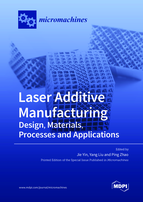Laser Additive Manufacturing: Design, Materials, Processes and Applications
A special issue of Micromachines (ISSN 2072-666X). This special issue belongs to the section "D3: 3D Printing and Additive Manufacturing".
Deadline for manuscript submissions: closed (31 August 2022) | Viewed by 40335
Special Issue Editors
Interests: additive manufacturing; laser advanced manufacturing; laser-matter interaction; numerical simulation; in situ characterization; microstructures; mechanical properties
Special Issues, Collections and Topics in MDPI journals
Interests: additive manufacturing; selective laser melting; crystal plasticity finite element; dynamic mechanical properties; titanium alloy; metal matrix composites
Special Issues, Collections and Topics in MDPI journals
Interests: micro/nano photonic devices; additive manufacturing; three-dimensional micro optical fabrication; nonlinear optics; optical communication
Special Issues, Collections and Topics in MDPI journals
Special Issue Information
Dear Colleagues,
Laser-based additive manufacturing (AM) is a revolutionary advanced digital manufacturing technology developed in recent decades, which is also a key strategic technology for technological innovation and industrial sustainability. This technology unlocks the design and constraints of traditional manufacturing and meets the needs of the complex geometry fabrication and high-performance part fabrication. A deeper understanding of the design, materials, processes, structures, properties, and applications are desirable to produce novel functional devices, as well as defect-free structurally sound and reliable AM parts.
This Special Issue of Micromachines entitled “Laser Additive Manufacturing: Design, Materials, Processes and Applications” aims to cover all the possible topics involved from macro- to micro-scale additive manufacturing with lasers, including structure design, fabrication, modeling and simulation, in situ characterization of additive manufacturing processes, and ex situ material characterization and performance, with an overview that covers various applications in aerospace, biomedicine, optics, and energy.
It is our pleasure to invite you to contribute original articles, comprehensive reviews, and letters/opinions to this Special Issue.
Dr. Jie Yin
Dr. Yang Liu
Dr. Ping Zhao
Guest Editors
Manuscript Submission Information
Manuscripts should be submitted online at www.mdpi.com by registering and logging in to this website. Once you are registered, click here to go to the submission form. Manuscripts can be submitted until the deadline. All submissions that pass pre-check are peer-reviewed. Accepted papers will be published continuously in the journal (as soon as accepted) and will be listed together on the special issue website. Research articles, review articles as well as short communications are invited. For planned papers, a title and short abstract (about 100 words) can be sent to the Editorial Office for announcement on this website.
Submitted manuscripts should not have been published previously, nor be under consideration for publication elsewhere (except conference proceedings papers). All manuscripts are thoroughly refereed through a single-blind peer-review process. A guide for authors and other relevant information for submission of manuscripts is available on the Instructions for Authors page. Micromachines is an international peer-reviewed open access monthly journal published by MDPI.
Please visit the Instructions for Authors page before submitting a manuscript. The Article Processing Charge (APC) for publication in this open access journal is 2600 CHF (Swiss Francs). Submitted papers should be well formatted and use good English. Authors may use MDPI's English editing service prior to publication or during author revisions.
Keywords
- additive manufacturing
- 3D printing
- laser powder bed fusion
- laser-directed energy deposition
- laser advanced manufacturing
- design and modeling
- materials
- processes
- characterization
- mechanical and functional properties
- applications









